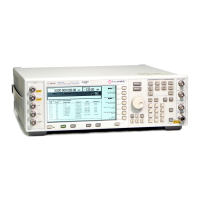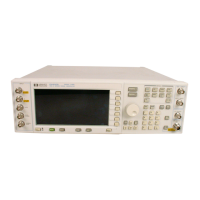418 Chapter 15
W-CDMA Digital Modulation for Component Test
W-CDMA Downlink Modulation
2. Press W-CDMA Define > Store Custom W-CDMA State > Store To File.
If there is already a file name occupying the active entry area, press the following keys:
Editing Keys > Clear Text.
3. Enter a file name using the alpha softkeys and the numeric keypad with a maximum length of 23
characters.
4. Press
Enter.
The user-defined W-CDMA downlink/uplink state is now stored in non-volatile memory and the file name is
listed in the catalog of files. Note that the actual waveform is not stored; the parameters for generating the
signal are stored. The RF output amplitude, frequency, and operating state settings are not stored as part of a
user-defined W-CDMA state file.
Recalling a W-CDMA Downlink/Uplink State
This procedure teaches you how to recall a W-CDMA state from the signal generator’s non-volatile memory.
If you have not created and stored a W-CDMA state, complete the steps in the previous sections, “Creating a
User-Defined W-CDMA Downlink State” on page 413 and “Storing a W-CDMA Downlink/Uplink State”
on page 417, then preset the signal generator to clear the stored CDMA waveform from volatile ARB
memory.
1. Press
Mode > W-CDMA > Arb W-CDMA.
2. Press
W-CDMA Select > Custom W-CDMA State.
3. Highlight the desired file.
4. Press
Select File.
5. Press
W-CDMA Off On until On is highlighted.
The firmware generates the user-defined W-CDMA waveform in volatile ARB memory. The waveform is
now modulating the RF carrier.
For instruction on configuring the RF output, see “Configuring the RF Output” on page 417.

